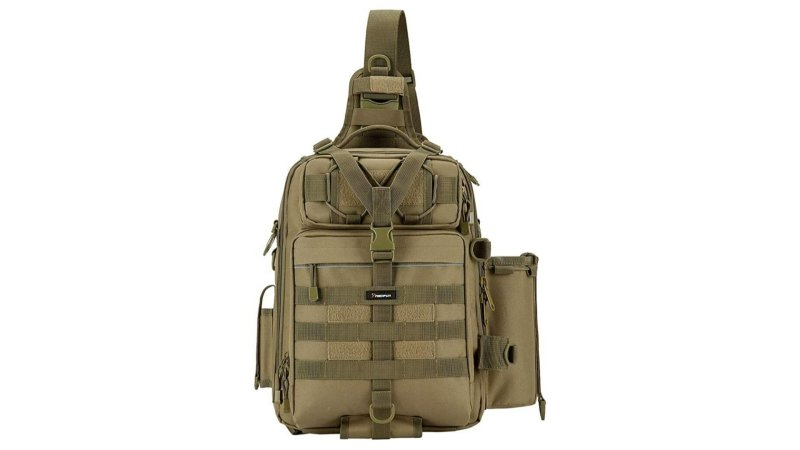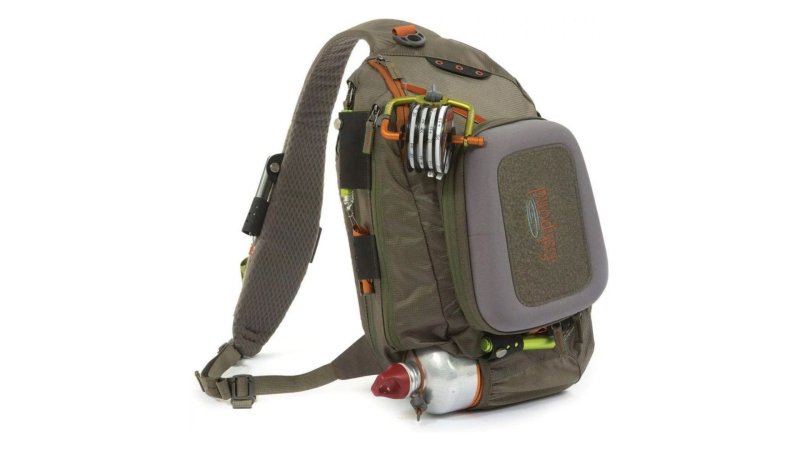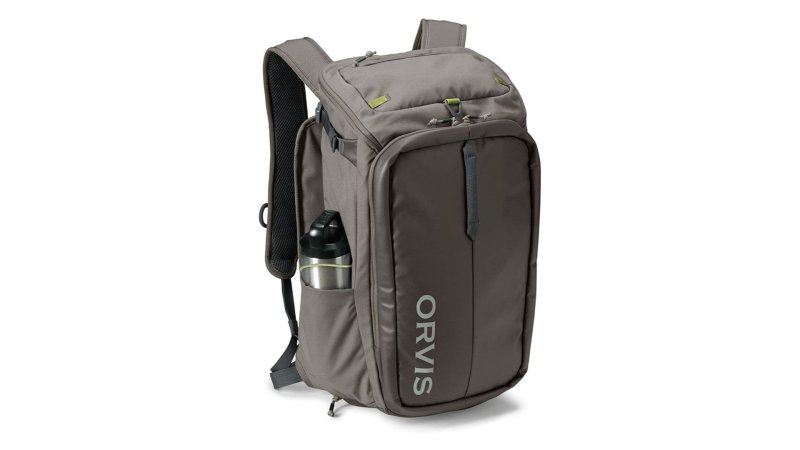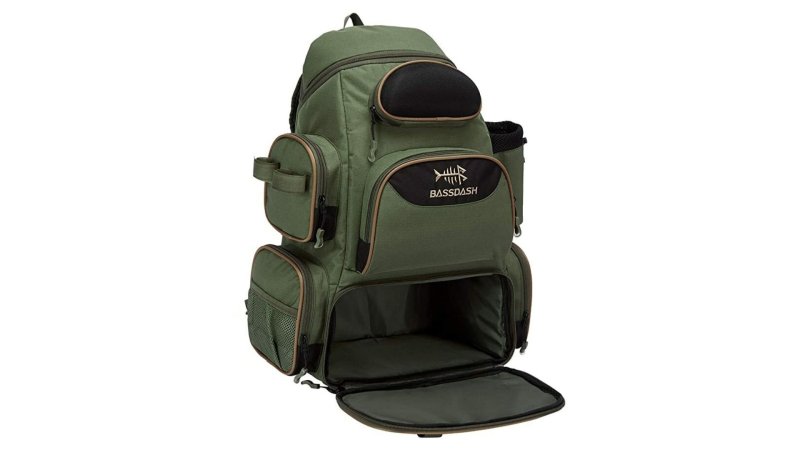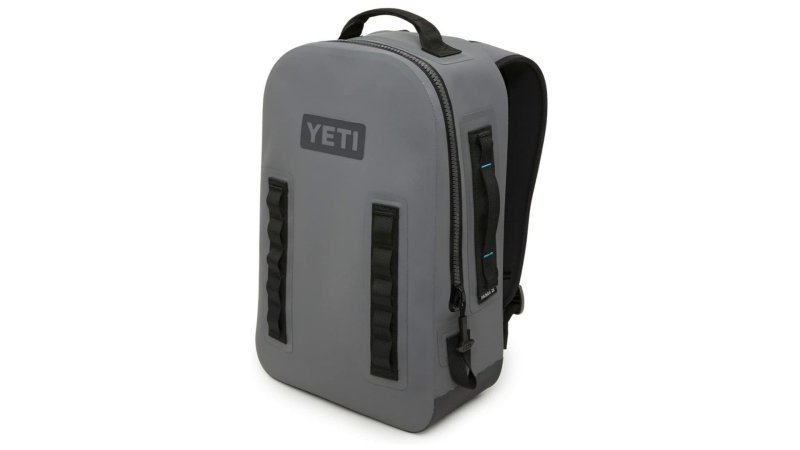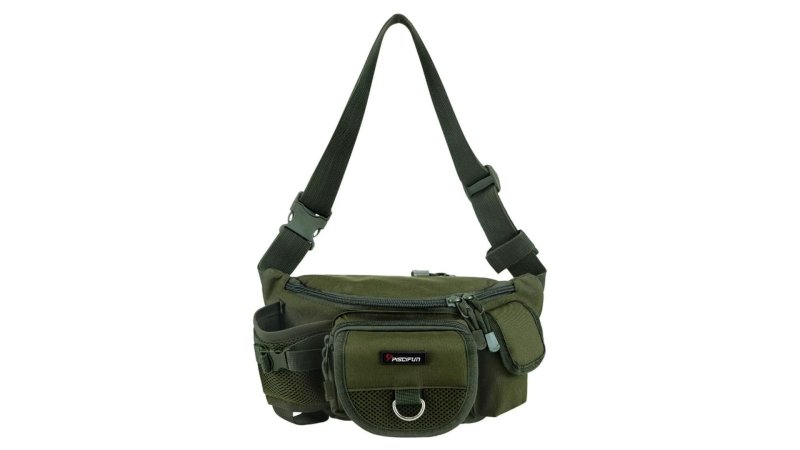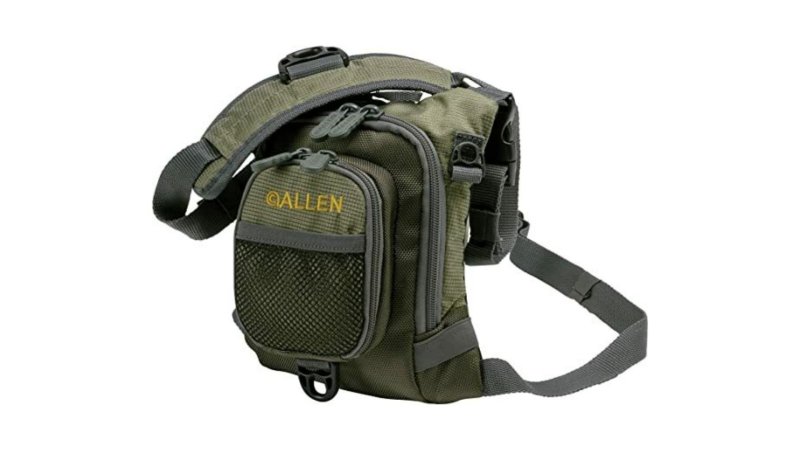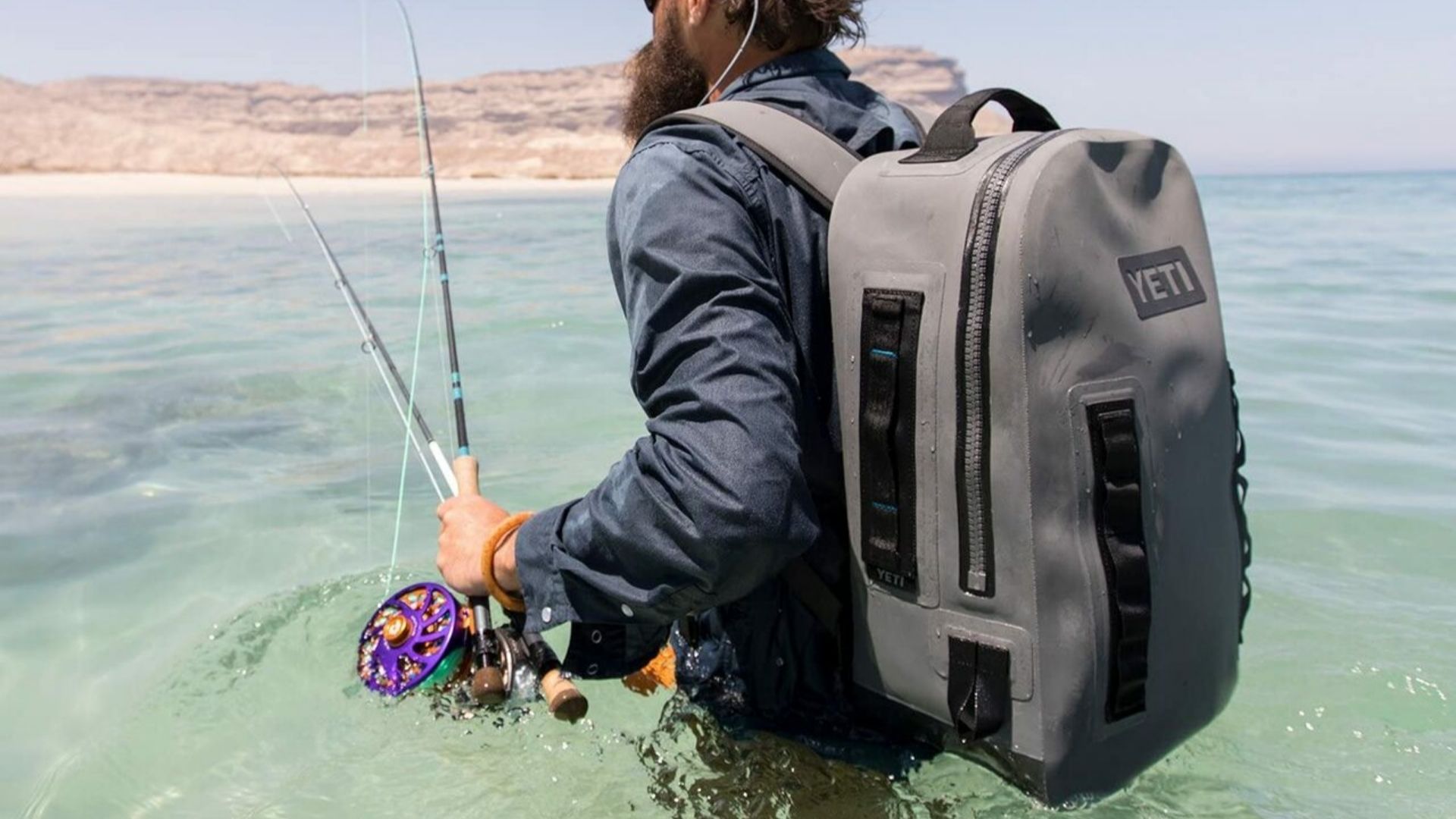

We may earn revenue from the products available on this page and participate in affiliate programs.
The best fishing backpacks can mean the difference between a relaxing morning on the water landing fish or a frustrating, under-equipped excursion. Fishing rivers, remote ponds, and large lakes can be a trial of trails just to get to your favorite fishing hole, and the last thing you need or want is to have to turn around and make multiple trips to your vehicle because you forgot your bait, favorite lure, fly box, or, God forbid, your fishing rod.
If you’re like me, you spent a lot of your youth fishing out of a plastic tackle box with fold-out trays that never quite closed over the secondhand tackle pilfered from your father’s gear. If so, you probably remember the looming fear of that tackle box inevitably getting dropped or kicked over, causing the inside to become a catastrophic mess of iron sinkers, swivels, oversized fluorescent bobbers, and rusty barbed hooks, just waiting for a misplaced finger. The tacklebox setup was all well and good when fishing a backyard pond for bluegill and the all-to-frequent bullhead, but as I’ve gotten older, my wanderings have gotten further and a normal fishing excursion usually involves a fair amount of hiking, which can quickly turn from tranquil to terrible when loaded down with more cumbersome tackle than two hands can carry.
Enter the fishing backpack: With a decent pack, you can put aside the need for a hand-carry tackle box and slip into your favorite fishing hole with ease. That said, not every angler is in it for the same species of fish or utilizes the same fishing style, so you should choose a fishing backpack best suited to your own personal practices. With this in mind, we’ve put together a list of our favorite fishing backpacks, to help you maximize your time with your line in the water.
- Best Overall: Wild River Tackle Tek Nomad Lighted Backpack
- Best Value: Piscifun Fishing Tackle Storage Bag
- Editor’s Choice: Fishpond Summit Sling Fly Fishing Backpack
- Best for Double Duty: Orvis Bug-Out Backpack
- Best for Tackle: BASSDASH Fishing Tackle Backpack
- Best Waterproof: YETI Panga Airtight Bag
- Best Hip Pack: Piscifun Portable Waist Bag
- Best Pack Bag: Allen Bear Creek Micro Fishing Chest Vest
Best Overall
Wild River Tackle Tek Nomad Lighted Backpack
Pros
- Abundant storage space
- Interior/exterior LED light
- Fold-out work surface
- Molded sunglasses holder
Cons
- Added features create additional weight
- Added features mean added cost
- No rod holders
Product Specs
- Manufacturer: Custom
- Leathercraft Dimensions: 18.5 inches x 17 inches x 8.5 inches
- Weight: 4.75 pounds
Best Value
Piscifun Fishing Tackle Storage Bag
Pros
- Built with water-resistant/durable nylon fabric
- Can carry in multiple configurations
- Built-in rod holder
- Bottom pockets for pliers or fish grippers
Cons
- Limited storage capacity
- Excessive amount of straps can be tricky
Product Specs
- Manufacturer: Piscifun
- Dimensions: 8.3 inches x 4 inches x 11.8 inches
- Weight: 1.76 pounds
Editor’s Choice
Fishpond Summit Sling Fly Fishing Backpack
Pros
- Comfortable carry with chest carry capability
- Fold-out work station
- Fly foam attachment with Velcro-ready surfaces
- Shoulder strap work station
Cons
- Higher price
- Limited storage capacity
Product Specs
- Manufacturer: Fishpond
- Dimensions: 13 inches x 8.5 inches x 9 inches
- Weight: 2 pounds
Best for Double Duty
Orvis Bug-Out Backpack
Pros
- Abundant storage space
- Side access flap
- Extendable rod tube holder
- Versatility of use
Cons
- Compartments not all tailored to fishing tackle
- Higher cost
Product Specs
- Manufacturer: Orvis
- Dimensions: 25 inches x 11.5 inches x 8 inches
- Weight: 2.2 pounds
Best for Tackle
BASSDASH Fishing Tackle Backpack
Pros
- Durable build
- Two rod holders
- Molded sunglass holder
- Lower cost
Cons
- Less “cool guy” stuff
- A bit bulky
Product Specs
- Manufacturer: Bassdash
- Dimensions: 19.7 inches x 15.7 inches x 7.9 inches
- Weight: 2.3 pounds
Best Waterproof
YETI Panga Airtight Bag
Pros
- Guaranteed waterproof
- Durable “ThickSkin” shell
- Spacious main compartment
Cons
- High cost
- Thick, waterproof material makes this bag boxy and rigid
- No rod holders or side pocket
Product Specs
- Manufacturer: Bassdash
- Dimensions: 12.5 inches x 7 inches x 20 inches
- Weight: 3.9 pounds
Best Hip Pack
Piscifun Portable Waist Bag
Pros
- Lightweight
- Inexpensive
- Versatile
- Durable
Cons
- Limited carry capacity
- Embarrassing to your children
Product Specs
- Manufacturer: Piscifun
- Dimensions: 12.2 inches x 4.7 inches x 5.3 inches
- Weight: 10.69 ounces
Best Pack Bag
Allen Bear Creek Micro Fishing Chest Vest
Pros
- Lightweight and low profile
- Fold-out work surface
- Built-in tippet tender and fly patch
Cons
- Limited carry capacity
- Geared mainly toward fly fisherman (which is only a con if you’re not one)
Product Specs
- Manufacturer: The Allen Company
- Dimensions: 3.0 x 5.75 x 7.5 Inches
- Weight: 0.66 lbs
Why you should trust us
Anyone who’s been in the military has learned a thing or two about space efficiency in backpacks and the importance of accessibility to pertinent gear. In fishing, as in the military, readiness and organization is often the key to success. My father was an avid fisherman who kept an above-average amount of tackle spread through a number of traditional-style tackle boxes and bags. He was meticulous in his organization, his preparation, and his execution. And though I haven’t reached his master-fisherman level, I like to think I picked up a thing or two along the way.
Types of fishing backpacks
Tackle backpack
A tackle backpack is a fishing backpack built with the primary function of holding tackle trays of various sizes. For the purpose of this review, I based all of my criteria on the #3600 tray size, which is a medium-size tackle tray and fairly common. Many of the tackle backpacks are characterized by dividable inner chambers with upper and lower access flaps. This feature allows the user to keep their tackle trays stacked and separated in a separate compartment and not mixed in with other gear or camping necessities. Most tackle backpacks offer a generous amount of side pockets for additional gear such as line spools, spare reels, and all the other bits and pieces that accumulate with years of fishing.
Sling backpack
Geared for the more mobile fisherman, sling backpacks allow an angler to stay on the move. A tackle backpack is likely to be set down along the shore or in a boat, but the sling backpacks are usually meant for long-term wear and are geared toward fishermen who are constantly changing location, looking for that magical spot where all the fish are biting. Most sling backpacks are equipped to either be worn over the back, or strapped across the fisherman’s front. The single strap allows the fisherman to easily slide the bag from their back to their chest, granting easy access to tackle without ever having to leave the water.
Hip back
Whoever said fanny packs went out of style never talked to a fisherman. Hip packs, like sling packs, are meant for constant wear, allowing the fisherman access to most of his vital gear without ever having to leave his position.
Chest pack
Generally geared to fly fishermen, chest packs are another great way to keep your gear accessible without having to trudge back into shore. Chest rigs tend to be a bit smaller than sling backpacks and hip packs in the interest of preserving range of motion during casting. It’s for this reason that chest packs are usually marketed more toward fly fishermen, who generally require less tackle and equipment needs. If you’re one to wade into deep water chasing trout, a chest pack is a good idea to keep your tackle high and dry.
Key features of fishing backpacks
Accessibility of gear
Nobody wants to get out to their favorite fishing hole and have to empty their backpack in search of a favorite lure or fly. When scouting for a fishing backpack, be sure to keep your specific gear needs in mind. If you’re a fly fisherman, look for a bag that allows you to keep your fly box at the front and ready. If you prefer lures instead, be sure to find a bag that keeps your tackle trays readily accessible. This may be a personal preference of mine, but I tend to lean toward bags with convenient outer attachments, such as plier sheaths, retractable lanyards for line clips, and carabiner loops for any number of other frequently needed tools. The less I have to go digging through pockets, the better.
Durability
If you’re looking for a fishing backpack, chances are you plan on fishing off the beaten trail, and rugged country requires a rugged bag. It is essential to ensure you have a bag that can stand up to the wilderness around you. Most fishing backpacks are made from thick canvas or nylon, which help them stand up not only to rocks and sticks, but also to the hooks and blades of your own tackle.
Balance
Whether you’re navigating a rough trail before sun-up or perched on a slippery rock in the middle of a quick current, you’re going to want a bag that’s well-balanced and keeps your tackle well-balanced too. Large or small, your fishing backpack should be comfortable on your back, with the weight evenly distributed. Not only that, but the weight within your backpack should be reasonably secured to prevent sudden shifts that could take you off balance on treacherous footing. Fishing is fun. Unexpect swims in the river are not.
Benefits of fishing backpacks
Access hard-to-reach fishing holes
Trailheads only go so far, and if you’re clattering about with fists full of tackle boxes, rods, nets, stringer lines, rain gear, and God knows what else, you’re probably not going much further than what ease of travel will allow. With a proper fishing backpack, off-roading becomes easier and even fun. With your hands-free and your world on your back, you can more easily navigate steep river banks, thick brush, and downed trees, leaving the overcrowded river access points behind. There’s nothing better than setting off on your own for a relaxing, solitary day on the river.
Keep your gear ready to go
When it’s zero-dark-30 and you’re heading to the river, the last thing you want to do is spend your time rounding up wayward gear or pulling specific bits of tackle from multiple boxes. A good fishing backpack will allow you to keep all your tackle together in one convenient, ready-to-go location. Wake up, grab your coffee, sling your backpack, and you’re on your way out the door.
Always be prepared
There’s nothing worse than making it out to your favorite fishing spot before anyone else, only to have the rain clouds open up and realize you forgot your wet weather gear back at the truck. With a fishing backpack, you can easily stow away rain gear, extra water, snacks, and other oddities that will keep you out longer. You can’t catch fish if you don’t have a line in the water, so come prepared and leave when you’re good and ready, not when some unforeseen need forces you to go.
Pricing considerations for fishing backpacks
Budget
This price range is typically where you’ll find most sling fishing backpacks, hip packs, and chest packs, though some of the more high-end bags may come in above the $50 price point, depending on how many extra features have been built in.
Mid-range
Between $50 and $100 is typically where you’d find most mid-grade tackle backpacks and high-end sling backpacks (such as the Fishpond Summit Sling listed above). You can find some very good tackle backpacks in this price range that won’t break the bank. Just don’t expect a lot of added bells and whistles.
Premium
Above $100 will be the price range for the more premium tackle backpacks. Price tends to rise with storage capacity and, as in the case of the Wild River Tackle Tek Nomad, the added extras that get built into the bags.
How we chose our top picks
Fishing is not a “one-size-fits-all” activity, and an angler’s needs in a fishing backpack can range widely depending on the style of fishing and the prospective quarry. With these different needs in mind, we tried to incorporate recommendations that would best cover the spectrum of needs. In order to find our best picks, we scoured countless lists of top tackle bags, sling bags, hip packs, and chest packs. We did hands-on testing of most of the listed bags, packing them with our own gear to test durability, accessibility, and storage capacity. We read customer reviews and bounced Amazon product pages off from manufacturing product pages to ensure the accuracy of information. After all of this, I feel confident in the recommendations we’ve made, and though I can’t guarantee you’ll catch more fish because of it, I can guarantee these bags will help you keep your line in the water for longer, which is usually half the battle.
FAQs on fishing backpacks
You’ve got questions, Task & Purpose has answers.
Q. What should be in a fishing backpack?
A: This will be dependent on the fish you’re after, but generally you should always carry pliers, additional line, bait/lures/flies, sunglasses, and a flask of your favorite bourbon.
Q. How do I choose a fishing backpack?
A: Determine the type of fishing you wish to pursue. Fly fishermen can generally get away with smaller backpacks. Lure and bait fisherman tend to have a need for more tackle, so a larger backpack may be required.
Q. What makes a fishing backpack better than a regular one?
A: A fishing backpack will have features tailored to fishing needs, such as rod holders, plier holders, net sleeves, and cargo space for tackle trays.
Q. Can I only use my fishing backpack for fishing?
A: Most fishing backpacks can serve double-duty as camping and day bags, though some are more suited for dual purpose than others.
Q. What components should I look for in a fishing backpack?
A: Ultimately, you should look for something comfortable that fits your specific fishing tendencies. Fishermen often spend long periods of time on their feet, so a comfortable bag is a must.

